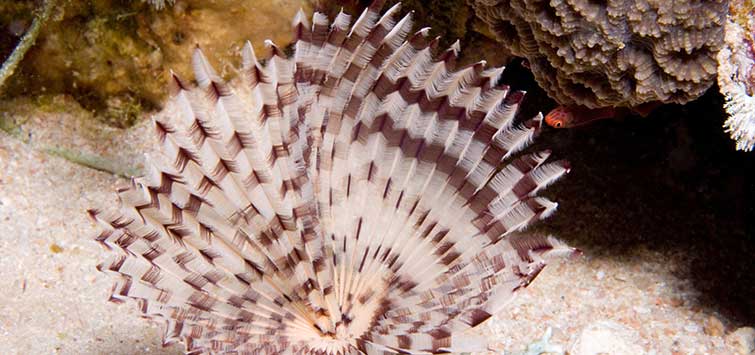Protula magnifica
Author: Bob Goemans
Common Names: Coco worm, magnificent tubeworm
Phylum: Annelida
Class: Polychaeta
Order: Sabellida
Family: Serpulidae
Range: Tropical Indo-West Pacific Ocean
Natural Environment: This species is usually found inhabiting shady rocky regions on current-swept reef slopes, where its calcareous tube is cemented to various types of substrate.
Water Requirements: Calcium 380 to 430 ppm; alkalinity 3.5 meq/l; pH 8.1 to 8.2; specific gravity 1.024 to 1.026, and a temperature range of 74 to 83 degrees Fahrenheit (23 to 28 degrees Celsius).
Captive Care
This large serpulid worm, which is probably the largest of calcareous tube worms, lives inside a hard white tube and is a suspension feeder. It has a double-headed set of gills, but lacks an operculum (trap door) to seal off the top entrance of the tube. Its tentacle crown approaches 3 inches (7.5 cm) in diameter, and its tube can be almost 1 inch (2.5 cm) in diameter and up to 8 inches (20 cm) in length.
Specimens are better placed near the bottom of the aquarium in shaded areas where gentle to moderate currents will help bring various foodstuffs. Lower areas that often produce current-swept detritus, a foodstuff that helps provide some nutrition. Stirring of the sandbed near the location of this tubeworm may also bring about a drifting cloud of foodstuffs.
Feeding
Frequent feedings, at least every-other day, with fresh or preserved phytoplankton additives are a must for long-term survival. Keep in mind these additives cannot be dispensed directly onto its gills, as the worm will quickly retreat back into its tube. In fact, it's also highly sensitive to changes in light intensity and will usually quickly retreat when a shadow passes over it. Dispense the additive into the aquarium's current and allow it to bring the foodstuff to the worm.
Tankmates
Tankmates that will pick on or eat tubeworms, e.g., triggerfish, angelfish, pufferfish, butterflyfish, crabs, peppermint shrimp, etc., should not be housed with this type of creature. When properly fed, these are hardy and long-lived vertebrates. When not given adequate nutrition and suitable tankmates, however, few will survive their first year of captivity. Much attention should be given to maintaining proper calcium and alkalinity levels as noted.

.png?h=595&iar=0&w=2781&hash=5FD5E69473BCC22199FBFA2FB71B6033)



